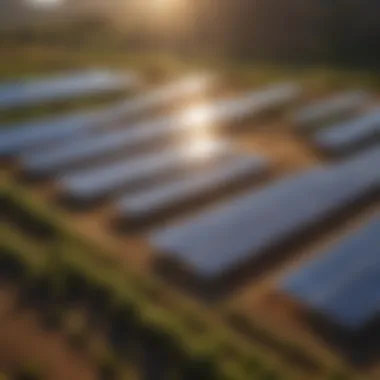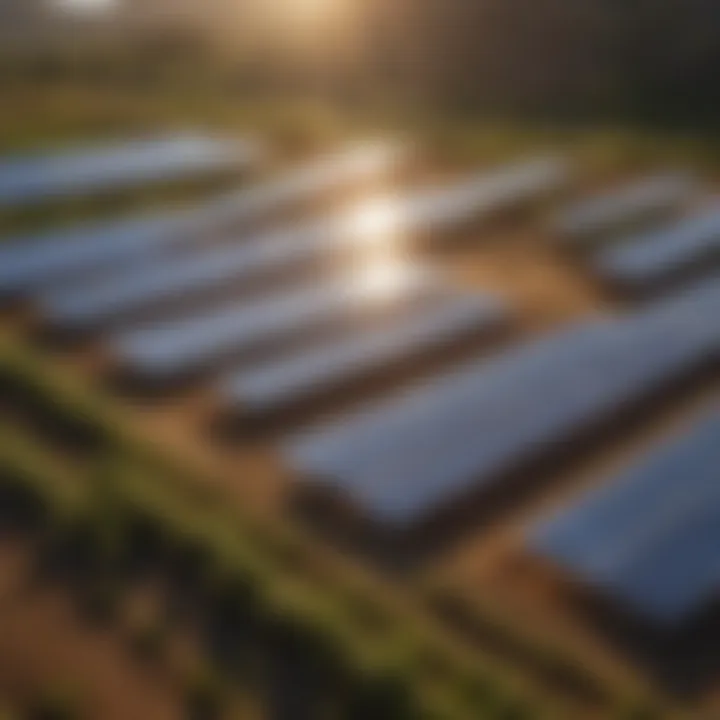Green Energy for America: Exploring the Future


Topic Overview
Definition and Importance
Green energy refers to energy derived from natural sources that are replenished at a faster rate than they are consumed. This includes renewable sources like solar, wind, and bioenergy. The importance of green energy lies in its potential to provide sustainable energy solutions while mitigating climate change and reducing environmental degradation. Transitioning to green energy isn’t merely a choice; it is essential for fostering a resilient economy and securing the future of our planet.
Brief History and Evolution
The journey toward green energy in America has evolved over several decades. The 1970s marked the initial interest in renewable resources, primarily due to the oil crisis. Policies began to take shape, with federal initiatives aimed at reducing reliance on fossil fuels. In the early 2000s, advancements in technology propelled solar and wind energy adoption. Today, green energy contributes a significant portion of electricity generation, reflecting a shift in public opinion and policy frameworks toward sustainability.
Key Techniques and Innovations
Solar Energy
Solar energy represents one of the most accessible forms of green energy. Technological advancements, such as photovoltaic cells, have fueled its growth. Various installations range from residential rooftops to large solar farms. The decline in costs has made solar energy economically viable. Key innovations include solar panels with higher efficiency rates and battery storage solutions that enhance usability.
Wind Energy
Wind energy has established itself as a leading renewable energy source in America. Wind turbines are now commonly found in both onshore and offshore locations. The development of larger and more efficient turbines plays a critical role in capturing energy more effectively. Furthermore, innovations in smart grid technology enable better management and distribution of this energy.
Bioenergy
Bioenergy harnesses energy from organic materials such as plant and animal waste. It supports waste management while producing energy. Biogas systems, which convert waste into usable energy, are gaining traction. Efficiency in production and the ability to scale make bioenergy a promising sector.
Practical Applications
Step-by-Step Guides
To implement green energy solutions, one must follow systematic steps:
- Assessment of Energy Needs: Evaluate current energy consumption to determine requirements.
- Feasibility Study: Analyze the suitability of solar, wind, or bioenergy given geographic and climatic conditions.
- Capital Investment: Estimate costs for installation and seek funding or incentives available for renewable energy.
- Technology Selection: Choose appropriate technology based on efficiency, budget, and longevity.
- Installation and Maintenance: Engage professionals for installation and establish a maintenance schedule to ensure long-term functionality.
Case Studies or Real-World Examples
Several examples demonstrate successful green energy adoption:
- Brookfield Renewable Partners has expanded its wind and hydroelectric capacity, contributing to energy diversification and sustainability.
- Tesla has focused on solar energy solutions and energy storage systems, promoting a modern approach to energy independence.
"Transitioning to green energy not only aids in combating climate change but also presents economic opportunities and energy security for the future."
Understanding Green Energy
Definition and Scope
Green energy refers to energy derived from sources that are naturally replenished. This concept emphasizes sustainability and environmental protection. The scope of green energy encompasses various technologies that harness renewable resources, including solar, wind, and bioenergy. Understanding this topic is crucial for grasping how these energy types can contribute to reducing carbon emissions and bolstering America's energy independence.
Green energy matters significantly because it offers a pathway to mitigate climate change impacts. It provides economic opportunities by creating jobs in renewable sectors. Furthermore, green energy is less reliant on finite fossil fuels, promoting long-term sustainability.
Types of Green Energy
Green energy includes several key types, each contributing uniquely to the overall goal of sustainable energy production. These are:
- Solar Energy
- Wind Energy
- Hydropower
- Geothermal Energy
- Bioenergy
Solar Energy
Solar energy harnesses sunlight using photovoltaic cells to generate electricity. The notable characteristic of solar energy is its widespread availability, making it an accessible option for many regions in America. Solar panels are often chosen for their ability to produce power with minimal environmental impact. A unique feature of solar energy is its capacity for decentralized energy generation, allowing homes and businesses to produce their own electricity. In this article, we explore how solar energy can significantly reduce reliance on traditional power grids.
Advantages of solar energy include its low operational costs once installed and capabilities to function well in remote areas. However, challenges include the initial installation costs and reliance on sunlight, which may limit effectiveness in less sunny regions.
Wind Energy
Wind energy uses turbines to convert wind motion into electrical power. Its key characteristic is efficiency; wind turbines can produce large amounts of energy with minimal land requirements. Wind energy is popular due to its low emissions and cost-effectiveness over time, making it a strong candidate in America’s quest for renewable resources.
Wind energy offers a scalable solution; new farms can expand as demand grows. A downside is the inconsistency of wind patterns which can affect energy supply. Additionally, there are concerns about the impact on bird populations and local ecosystems.
Hydropower
Hydropower generates electricity from the flow of water. The primary appeal of hydropower lies in its established technology and the ability to provide baseload power—meaning it can continuously produce energy. This reliability is crucial for balancing out other intermittent energy sources like solar and wind.
A unique feature of hydropower is its ability to store potential energy through pumped storage systems. However, it also has disadvantages, such as ecological disruption due to dam construction and potential impacts on local fisheries.
Geothermal Energy
Geothermal energy taps into heat from below the Earth's surface to produce electricity or provide direct heating solutions. It's often praised for its reliability, as geothermal plants can operate continuously. This consistency makes it a valuable player in a reliable energy portfolio.
One standout aspect of geothermal energy is its minimal land footprint compared to other renewable sources. Nevertheless, it is limited to areas with suitable geological conditions, which can restrict its widespread adoption.


Bioenergy
Bioenergy is derived from organic materials, such as plants and waste. Its defining characteristic is flexibility; it can be used for electricity, heating, and as transportation fuel. This adaptability makes bioenergy a versatile component in green energy strategies.
While bioenergy can be sustainably managed, there are concerns around land use and food competition. Its production needs careful balancing to avoid negative effects on food supply and biodiversity.
By understanding these types of green energy, we can better appreciate their role in shaping a sustainable future for America.
Historical Context of Green Energy in America
Understanding the historical context of green energy in America is essential. It reflects how various factors have shaped current practices in renewable energy adoption. Society’s movements toward greener solutions began as far back as the early 20th century. The evolution of technology, economic influences, and changing public perception have all contributed to a landscape that embraces sustainability today. By studying these elements, one can appreciate the foundations upon which current green energy initiatives are built.
Early Adoption
The early adoption of green energy technologies in America can be traced to experimentation with renewable sources. In the late 1800s, small-scale hydropower plants began to arise in rural areas. They powered homes and mills, showcasing the potential of utilizing natural resources. However, these initial efforts were often piecemeal and lacked a unifying framework. During the 1970s energy crisis, focus on renewable resources surged. Public concern about fossil fuels prompted increased interest in alternatives. Solar panels and wind turbines gained traction during this time as viable energy sources. This early commitment set the stage for future technologies and policies that would further enhance renewable energy integration into the grid.
Policy Milestones
Policy milestones throughout the decades significantly shaped America’s approach to green energy. Legislation has played a critical role by establishing frameworks that support renewable energy projects.
Renewable Energy Standards
Renewable Energy Standards, or RES, are fundamental regulations that require utilities to obtain a certain percentage of their energy from renewable sources. This policy aims to encourage the growth of renewable energy technologies. A key characteristic of RES is its flexibility, allowing states to set their targets according to local resources. This makes it popular among various stakeholders. The unique feature of RES is its ability to create a reliable demand for renewables, stimulating investments. However, some critics argue that these standards may impose additional costs on consumers and utilities.
Investment Tax Credits
Investment Tax Credits, also known as ITCs, provide tax incentives for individuals and businesses investing in renewable energy projects. This policy has become a powerful tool for stimulating growth in solar and wind sectors. One notable characteristic of ITCs is their direct financial benefit, allowing projects to offset a portion of their installation costs. This makes ITCs a beneficial choice for promoting renewable energy development. The unique feature of ITCs is their broad application across different types of renewable energy technologies. On the downside, uncertainty regarding the longevity of these credits can affect investor confidence in the long term.
Stimulus Packages
Stimulus packages, particularly during economic downturns, often include incentives for renewable energy. These packages tend to inject significant amounts of federal funding into clean energy projects. A central characteristic of stimulus packages is their capacity to respond swiftly to economic needs while promoting green technologies. Such initiatives can inject vital capital during times of financial distress, making them popular among policymakers and investors alike. One unique feature is their dual benefit of immediate economic relief while transitioning towards a sustainable future. However, reliance on stimulus can lead to periods of volatility in funding and project continuity.
"Historical context not only enlightens current practices but also illuminates the trajectory of green energy in America."
The historical context of green energy in America reveals its layered development, driven by technological innovation and pivotal policy decisions. By understanding this context, stakeholders can better appreciate modern efforts and anticipate the potential directions of future energy policies.
Current Landscape of Green Energy
The current landscape of green energy in America plays a pivotal role in defining the future of sustainable development and economic resilience. As the nation grapples with climate change and a growing energy demand, the transition towards renewable energy sources is more critical than ever. This section explores the ongoing market trends and geographical disparities, shedding light on how diverse regions are responding to the call for cleaner energy.
Market Trends
The market trends in green energy reveal a shift in both consumer preferences and investor interests. Increasing awareness of environmental issues alongside fluctuating fossil fuel prices has prompted individuals and businesses to seek out renewable options. Key trends include:
- Rising Investment: Financial inflows into solar and wind sectors have seen substantial growth, often outpacing traditional energy investments.
- Cost Reduction: The cost of solar panels and wind turbines has dropped significantly, making them more accessible to a wider audience.
- Distributed Generation: A growing number of households are opting for rooftop solar installations, leading to more distributed energy generation models.
These trends indicate a robust and evolving market for green energy solutions.
Geographical Disparities
The geographical disparities in green energy adoption illustrate the varied landscape across the United States. Some regions are leading the way in renewable energy production while others are just beginning to explore their potential.
Regional Leaders in Renewable Energy
In our analysis of regional leaders in renewable energy, states like California, Texas, and New York stand out. Each has a unique character that contributes to its status:
- California: Renowned for its ambitious climate goals and vast solar capacities, California has invested heavily in infrastructure and technologies for solar energy. The state's aggressive renewable energy targets support a powerful green economy.
- Texas: Surprisingly, Texas has become a leader in wind energy. Its vast open spaces and favorable wind patterns have resulted in the nation’s largest wind energy generation capacity. This has turned Texas into a significant player in the renewable energy market.
- New York: Focused on a diversified approach, New York combines solar, wind, and hydropower to create a balanced energy portfolio. The state's programs encourage investment in renewable resources, enhancing its green credentials.
These regional leaders showcase the possibilities of harnessing renewable resources effectively, highlighting their significant contributions to the fight against climate change.
States with Emerging Markets
In contrast to the established regions, some states are developing emergent markets in green energy:
- Florida: Known for its sunshine, Florida has seen a surge in solar energy initiatives. The state is expanding its solar capacity, although regulatory hurdles slow progress.
- North Carolina: Rapidly rising in solar adoption, North Carolina ranks among the top states for solar power. Its supportive policies promote growth, engaging local economies.
- Colorado: With a reputation for progressive environmental policies, Colorado is investing in wind and solar energy, attracting interest from investors and innovators.
While emerging markets present great potential, they face obstacles. Navigating local regulations and securing investment are ongoing challenges, yet the prospects remain promising.
"The transition to green energy not only mitigates environmental impacts but also drives economic growth in diverse sectors."
These insights into the current landscape of green energy indicate a dynamic and rapidly changing environment. As markets evolve, the role of state policies, technological innovations, and community involvement will significantly shape the pathway to a more sustainable future.
Economic Implications of Green Energy
The economic implications of green energy extend far beyond merely replacing fossil fuels. As America continues its transition toward renewable energy, the effects on the economy are profound, affecting job markets, investment flows, and broader economic growth. Understanding these implications helps clarify why green energy is not just an environmental necessity but also a strategic economic opportunity for the nation.
Job Creation in Renewable Sectors
The renewable energy sector has proven to be a substantial engine for job creation. Over the past decade, industries like solar and wind have seen rapid expansion. According to the Solar Foundation's National Solar Jobs Census, there are now more than 250,000 solar workers in the U.S., a number which has grown steadily as technology advances and costs decrease. Job roles in this sector encompass a wide range of skills, from installation to maintenance, thus creating opportunities for a diverse workforce.


Job creation is not limited to direct employment in renewable projects. The economic benefits ripple through local economies, as support jobs in areas like manufacturing, logistics, and sales emerge. Additionally, as energy costs decrease with increased use of renewables, household income can potentially rise, leading to a greater demand for products and services. This contributes to a cycle of economic growth, enhancing community resilience.
Investment Trends
Investment in green energy is a significant component of its economic implications. The trend is shifting as both public and private sectors recognize the long-term potential for return on investment.
Venture Capital in Clean Tech
Venture capital plays a crucial role in the clean tech space. By investing in startups and innovative projects, venture capitalists are fueling advancements in energy technology. This influx of capital is essential for developing efficient solutions that can compete against traditional energy sources.
One key characteristic of venture capital in clean tech is its attractiveness to investors looking to gain early access to emerging technologies. It presents a unique opportunity. By funding cutting-edge research and development, venture capital ensures that the most promising ideas receive support, thus facilitating progress.
However, there are disadvantages to consider. The high-risk nature of startups means that investors may not see quick returns. Yet, this risk can be mitigated by choosing ventures that show proven potential for scalability and profitability.
Public vs Private Investment
When comparing public and private investment, both have their unique roles and impacts. Public investment often provides grants and incentives meant to lower the risk for businesses pursuing renewable energy initiatives. This type of funding is essential to kickstart projects that may otherwise struggle to find backing.
On the other hand, private investment, typically from venture capital and private equity, drives innovation and rapid growth. Investors in this space often seek high returns, which pushes companies to innovate quickly and efficiently.
The advantages of public investment include stable funding sources, which can lead to long-term sustainability. Private investments, although higher risk, can yield significant returns in shorter time frames adding to the dynamic growth of the sector.
Ultimately, the synergy between both types of investments allows for a balanced growth trajectory and reinforces the viability of green energy as a cornerstone of the American economy.
Environmental Benefits
Environmental benefits are a cornerstone of the green energy narrative. By transitioning from fossil fuels to renewable energy sources, there are substantial positive impacts on both climate health and ecological integrity. This section emphasizes how green energy mitigates climate change and promotes biodiversity, which is critical for sustained agricultural productivity and soil health.
Reduction of Greenhouse Gas Emissions
One of the most compelling reasons for adopting green energy is its role in reducing greenhouse gas emissions. Traditional energy sources like coal, oil, and natural gas are significant contributors to carbon dioxide emissions, which drive climate change. In contrast, renewable energy technologies such as solar panels, wind turbines, and hydroelectric dams generate power with little to no direct emissions. For instance, when the United States increased its renewable energy generation from solar and wind, it has led to notable drops in overall emissions.
The shift away from fossil fuels also opens avenues for carbon capture and storage technologies that further lessen the environmental burden. Beyond reducing emissions, these changes also promote cleaner air quality. Improved air quality leads to health benefits for communities, particularly those near industrial sites. As the green energy movement gains momentum, it offers a pathway not just for energy independence but also for a healthier planet.
Biodiversity and Ecosystem Health
Sustainable energy sources also contribute positively to biodiversity and ecosystem health. Fossil fuel extraction and usage inflict severe damage on ecosystems. Habitat destruction, pollution, and climate change create stressors that lead to declines in species populations. Transitioning to green energy reduces these threats, allowing ecosystems to recover and thrive.
For example, the establishment of wind parks can provide new habitats for birds and insects if designed thoughtfully. Solar farms can also integrate agricultural practices, promoting agrivoltaics, where crops are grown underneath solar panels, benefiting both energy production and food security. Furthermore, preserving diverse ecosystems aids in soil health, water cycles, and natural pest control, ultimately supporting sustainable agriculture practices.
"Sustainable energy not only powers the future but also nurtures the environment that sustains our very lives."
Challenges Facing Green Energy Adoption
The pursuit of green energy in America presents several challenges that can impact its adoption rate. Understanding these obstacles is crucial for addressing them effectively and harnessing the benefits that renewable energy can provide. The importance of this section lies in its exploration of both technological and regulatory barriers, which can significantly influence the growth and implementation of green energy initiatives. By dissecting these challenges, we will uncover the nuances that can hinder or expedite progress in this essential sector.
Technological Barriers
Technological barriers are one of the primary challenges facing the widespread adoption of green energy. Many renewable resources, while promising, still require advancements to reach their full potential. One significant limitation is the efficiency of energy conversion in solar panels and wind turbines. Current technologies may not capture enough energy for extensive commercial viability. Moreover, battery storage technologies have yet to achieve the efficiency necessary to store energy for long periods and manage input from intermittent sources like wind and solar, leading to challenges in reliability.
Investment in research and development is necessary to overcome these technological limitations. There’s a strong need for innovations that reduce costs and improve the efficiency of existing technologies. Fostering an environment that encourages technological advancement is essential for establishing a sustainable energy future.
Regulatory Hurdles
Regulatory hurdles can impede the fast-paced adoption of green energy. These hurdles often manifest as bureaucratic processes that delay project approvals and increase operational costs. Successful navigation of these regulations is crucial for green energy projects to come to fruition.
Permitting Processes
The permitting processes involved in green energy projects can be lengthy and complex. Achieving the necessary permissions often requires multiple layers of approval from federal, state, and local agencies. This complexity can deter potential investors and developers, creating uncertainty around project timelines. Permitting is characterized by its requirement for extensive documentation and compliance, making it a time-consuming endeavor.
An efficient permitting process has the potential to expedite project initiation and lead to increased investment in green technologies. Despite the challenges, streamlined regulations can pave the way for a smoother transition to renewable energy systems.
Interstate Commerce Issues
Interstate commerce issues also present significant barriers to green energy adoption. These challenges arise when energy infrastructure expands across state borders. Different states may have varying rules regarding energy distribution and grid interconnections. This inconsistency can limit the ability of green energy providers to effectively deliver electricity where it is needed most.
Transporting electricity generated in renewable locations to urban centers requires robust interconnections, which are often hindered by differing state regulations. Addressing interstate commerce concerns is vital for creating a unified framework that supports energy distribution, improving overall access to green energy.
By understanding regulatory hurdles, stakeholders can advocate for improvements that foster the integration of renewable resources across state boundaries and reduce confusion for developers.
The Role of Technology in Advancing Green Energy
The integration of technology into green energy is a pivotal aspect for developing sustainable energy solutions in America. Advancements in technology not only improve the efficacy of renewable energy systems but also drive down costs, making these alternatives more accessible to the general populace. This section will explore two critical areas: innovations in storage solutions and the role of smart grids in energy management. Each represents significant steps forward in how energy is generated, distributed, and consumed.
Innovations in Storage Solutions
Storage solutions are essential for balancing energy supply and demand, especially in renewable energy sectors like solar and wind. Unlike fossil fuels, which can provide a constant output, renewable energy sources often produce variable amounts of electricity based on weather conditions. As such, the development of advanced storage technologies has become a focus in the green energy sector.


One prominent innovation is the use of lithium-ion batteries. These batteries are becoming increasingly efficient at storing large volumes of energy. They are widely used in electric vehicles and for home energy storage systems, like those offered by Tesla with their Powerwall product. Both residential and commercial setups benefit from the ability to capture energy during peak production times and release it when needed.
Another method of energy storage gaining traction is pumped hydroelectric storage. This technique involves pumping water to a higher elevation during times of low demand and releasing it through turbines to generate electricity during peak demand. Although this approach requires significant capital investment, it offers a renewable solution for stabilizing power output.
"Energy storage is not just about keeping lights on; it can significantly enhance the reliability of renewable energy systems and foster investor confidence in green technologies."
Smart Grids and Energy Management
Smart grids integrate digital technology with traditional electricity networks to improve the efficiency and reliability of energy distribution. They allow for better energy management and can adapt to peaks in demand, minimizing waste and reducing reliance on fossil fuels.
Through smart technologies, energy consumers can monitor their usage and adjust consumption based on real-time data. This flexibility can lead to cost savings and a decrease in energy consumption during peak periods. For instance, smart meters provide users with detailed information on their energy usage patterns, enabling them to optimize their power consumption.
Moreover, smart grids facilitate the integration of diverse energy sources into the grid, such as solar and wind. They can manage the flow of energy efficiently, accommodating the intermittency of renewable sources. The result is a more resilient energy infrastructure that can react dynamically to changes in demand and supply.
In summary, the role of technology in advancing green energy is crucial. Innovations in storage solutions and the implementation of smart grid technology are key to enhancing the feasibility and reliability of renewable energy sources. As technology continues to evolve, it will open new pathways for green energy adoption not just in America, but worldwide.
Public Perception and Awareness
Understanding public perception and awareness regarding green energy is crucial for the successful implementation of renewable energy initiatives. The transition to green energy depends greatly on the attitudes and beliefs of communities. If people view renewable energy positively, it can lead to stronger community support and policy advocacy. Conversely, skepticism and misinformation can hinder progress, making it imperative to address these issues.
Community Involvement and Support
Community involvement is a key factor in advancing green energy projects. Residents who are actively engaged in local energy initiatives are more likely to support sustainable practices. Education about the benefits of renewable energy can foster community action and investment. For example, neighborhood solar programs allow citizens to install solar panels together, reducing costs through bulk purchasing. This collaborative approach not only promotes a sense of ownership but also encourages neighbors to advocate for further green energy solutions.
Benefits of community involvement include:
- Increased awareness of energy efficiency practices.
- Creation of local jobs in renewable sectors.
- Enhanced community resilience through sustainable resources.
Moreover, when communities come together to support green initiatives, it can attract investment. Local governments may become more willing to allocate funds for renewable energy projects if they see strong community backing.
The Influence of Media
Media plays a pivotal role in shaping opinions about green energy. Through news reports, documentaries, and social media campaigns, information about renewable energy reaches a broad audience. Positive media portrayals can inspire public interest and enhance understanding. Misleading or negative coverage, however, can perpetuate myths and create distrust.
To effectively use media for promoting green energy, consider the following:
- Presentation of Data: Use visuals to convey the benefits and impacts of renewable energy clearly.
- Success Stories: Highlight local or national projects that have yielded positive results to inspire others.
- Engagement: Encourage discussions through platforms like Reddit or Facebook to address concerns and misconceptions.
According to studies, effective media communication significantly influences public perception on sustainability.
"The way information is framed can enhance or detract from public support for renewable energy initiatives."
Policy Frameworks Supporting Green Energy
Policy frameworks are crucial in promoting green energy across America. These frameworks create an environment where renewable energy solutions can flourish and compete with traditional energy sources. The necessity for such policies arises from the inherent challenges faced by renewable energy sectors. Without supportive legislation and programs, investments may falter, stunting growth potential in an industry that offers substantial environmental and economic benefits.
Federal Initiatives and Programs
At the federal level, various initiatives are implemented to bolster the development and integration of green energy within the national energy grid. Key programs include the Investment Tax Credit and Production Tax Credit, which provide financial incentives for individuals and organizations investing in renewable energy projects. These credits have significantly stimulated the solar and wind sectors, leading to increased capacity and technology advancement.
Another important federal initiative is
- The Clean Power Plan (though currently reviewed), aiming to reduce carbon emissions from power plants by establishing state-specific goals.
- Additionally, the Department of Energy actively funds research and development for new technologies, enhancing efficiency and reducing costs in renewable energy systems.
The federal government also supports the deployment of battery storage and smart grid innovations, ensuring that renewable energy can be effectively integrated into existing infrastructures. These programs reflect a cohesive strategy directed toward achieving a cleaner, more sustainable energy landscape for the future.
State-Level Policies
State governments play a pivotal role in supporting green energy through their unique policies and incentives. Each state can tailor its approach based on local resources and energy needs, leading to diverse yet effective strategies across the nation. For example, California has been a leader in advancing renewable energy through aggressive targets for solar and wind investments. Their Renewable Portfolio Standard mandates that a significant portion of the state's energy come from renewable sources by specific deadlines.
Many states also offer Net Metering policies, allowing consumers with solar panels to receive credits for excess energy they produce and feed back into the grid. Such policies not only encourage individual investment in renewable technologies but also foster community-wide energy resilience.
Other notable state policies include:
- Solar Renewable Energy Certificates (SRECs) which reward solar energy producers for their generation.
- Renewable Energy Credits (RECs) which provide a market-driven incentive for all types of renewable energy producers to invest and expand their generation capabilities.
Future Outlook for Green Energy in America
The future of green energy in America presents a compelling vision characterized by innovation and sustainability. As the discourse around renewable energy intensifies, understanding the possible outcomes of these changes becomes essential. The section outlines critical projections related to growth and potential technological advances, emphasizing their significance.
Projected Growth Rates
The projected growth rates for green energy in the United States show promise. By 2030, analysts suggest that renewables could contribute as much as 50% of the country’s energy needs. This demonstrates a significant shift from traditional fossil fuels to greener options. Factors driving this growth include increased government support, advancements in technology, and rising environmental awareness among consumers. Solar and wind energy, in particular, are expected to dominate this landscape due to their declining costs and scalability.
- Solar Energy: The capacity for solar power is expected to triple in the coming decade. The reduction in manufacturing costs along with better efficiency rates will make solar more accessible.
- Wind Power: Offshore wind projects are projected to increase dramatically, with forecasts suggesting expansion to several gigawatts of installed capacity.
- Bioenergy Growth: The bioenergy sector will see developments in agricultural waste utilization, providing a dual benefit of reducing waste and generating energy.
Understanding these growth rates helps stakeholders, particularly in the agricultural sector, to align their strategies with emerging energy trends.
Potential for Technological Disruption
Technological disruption holds substantial potential for reshaping the green energy sector. This innovation could alter not only energy production but also consumption patterns across industries. Advancements in energy storage, smart grids, and electric vehicle integration will play pivotal roles. Here’s what to consider:
- Energy Storage: Improvements in battery technology could facilitate the storing of excess energy generated during peak production times. This will allow for a stable energy supply, reducing reliance on fossil fuel backup systems.
- Smart Grids: The implementation of smart grid technology can enhance energy distribution efficiency. These grids can respond to real-time energy demands, optimizing resource allocation and minimizing waste.
- Electric Vehicles: The growing adoption of electric vehicles presents opportunities for renewable energy integration into transportation, encouraging a shift in daily energy consumption habits.
"The intersection of technology and renewable energy has the potential to redefine how we approach energy consumption and sustainability."



